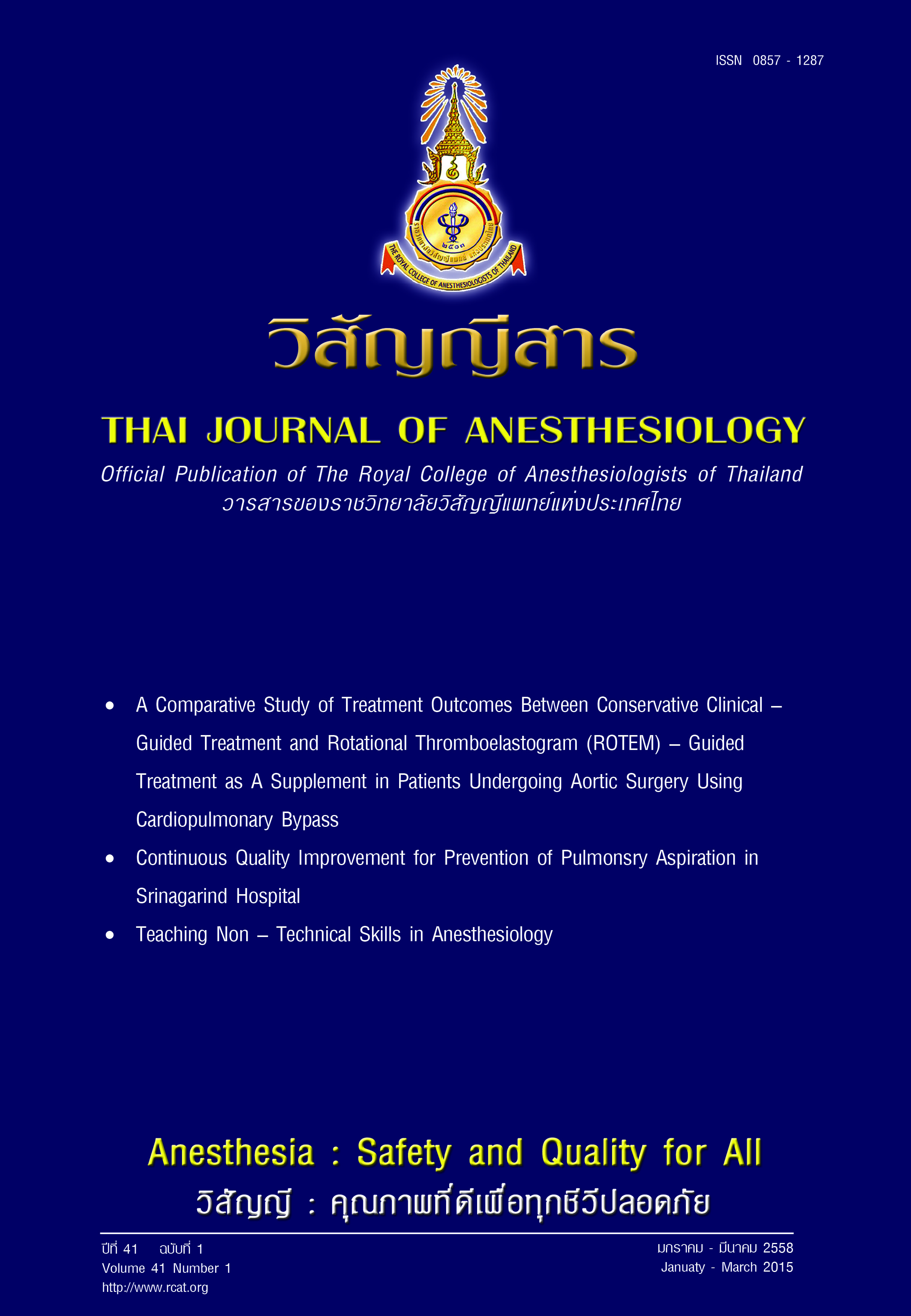Hemodynamic Effects of Anesthetic Induction in Elderly Patients Undergoing Cardiac Surgery: A Randomized Double - Blinded Study Between Etomidate and Thiopentone
Main Article Content
Abstract
Background: Many intravenous induction agents have been chosen upon many factors including patient status, hemodynamic profile, left ventricular function, type of surgery and others.
Objectives: To compare the hemodynamic effects of two induction agents, etomidate and thiopentone in elderly patients undergoing elective cardiac surgery.
Methods: A prospective, randomized, double - blinded study was conducted in 92 elective elderly (> 60 years) cardiac patients. They were divided into two groups according to induction agents (etomidate and thiopentone). The co-induction technique with midazolam and fentanyl was used in every patients. Mean arterial pressures (MAP) and heart rate were measured and compared at baseline (before induction), after induction and after intubation. The patients’ characteristic, peri-operative management and postoperative outcome were also recorded.
Results: The average age in thiopentone group was significantly higher (70.2 ± 7.7 yr. VS 65.6 ± 5.4 yr., p = 0.002). There were no other differences in patients’ characteristics including euroscores. The average dose of etomidate was 9.7 ± 4.9 mg or 0.15 ± 0.08 mg/kg and the average dose of thiopentone was 101.2 ± 44.7 mg or 1.88 ± 1.04 mg/kg. There were some changes in hemodynamic profiles during induction and intubation within the subject groups but not between groups even with patients with low cardiac ejection fraction. The inotropic uses, ventilator times and ICU stays did not differ between groups.
Conclusions: With co - induction technique, etomidate and thiopentone demonstrated stable hemodynamics in elective elderly patient
การเปลี่ยนแปลงของความดันดลือดและชีพจรหลังการฉีดยานำสลบในผู้ป่วยสูงอายุที่มา รับการผ่าตัดหัวใจ: การศึกษาเปรียบเทียบแบบสุ่มระหว่างอีโตมิเดตกับธัยโอเพนโทน
บทนำ: ยาฉีดนำสลบมีหลายชนิด การเลือกชนิดและขนาดของยานำสลบขึ้นกับหลายๆ ปัจจัย เช่น สภาพระบบไหลเวียนเลือดของผู้ป่วย ประสิทธิภาพการบีบตัวของหัวใจ การผ่าตัดและเหตุผลอื่น ๆ
วัตถุประสงค์: ต้องการเปรียบเทียบการเปลี่ยนแปลงของระบบไหลเวียนเลือดของยานำสลบสองชนิดอีโตมิเดต กับธัยโอเพนโทนในผู้ป่วยสูงอายุที่มารับการผ่าตัดหัวใจ
วิธีการ: การศึกษาไปข้างหน้าโดยการสุ่มผู้ป่วยสูงอายุ (> 60 ปี) ที่มารับการผ่าตัดหัวใจอย่างไม่เร่งด่วน 92 คน เป็น 2 กลุ่ม ให้ได้รับยานำสลบอีโตมิเดตหรือธัยโอเพนโทน ร่วมกับการได้รับเฟนตานิลและมิดาโซแลม มีการวัดความดัน ชีพจร ตอนแรก หลังได้รับยานำสลบ และหลัง การใส่ท่อหายใจ มีการบันทึกข้อมูลทั่วไปของผู้ป่วย การดูแลรักษาที่ได้รับ และผลลัพธ์
ผลการศึกษา: ผู้ป่วยใน กลุ่มธัยโอเพนโทนมีค่าเฉลี่ยอายุที่มากกว่าเล็กน้อย (70.2 ± 7.7 ปี VS 65.6 ± 5.4 ปี, p = 0.002). ข้อมูลอื่นๆของผู้ป่วยสองกลุ่มไม่ต่างกันรวมทั้งยูโรสกอร์ ค่าเฉลี่ยของขนาดยาอีโตมิเดตอยู่ที่ 9.7 ± 4.9 มก. หรือ 0.15 ± 0.08 มก./กก. และค่าเฉลี่ยของขนาดยาธัยโอเพนโทนอยู่ที่ 101.2 ± 44.7 มก. หรือ 1.88 ± 1.04 มก./กก. มีการ เปลี่ยนแปลงของความดันเลือด ชีพจรหลังการนำสลบและใส่ท่อหายใจของผู้ป่วยทั้งสองกลุ่มแต่ไม่มีความ แตกต่างระหว่างกลุ่ม แม้ว่าจะมีการวิเคราะห์แยกในผู้ป่วยที่มีการบีบตัวของหัวใจที่ไม่ดี ค่าอื่น ๆ ก็ไม่แตกต่างกัน เช่น ปริมาณการใช้ยาช่วยการบีบตัวหัวใจ ระยะเวลาการใช้เครื่องช่วยหายใจหลังการผ่าตัด ระยะเวลาการอยู่ไอซียู
สรุป: ด้วยวิธีการใช้ยานำสลบร่วมกับเฟนตานิลและมิดาโซแลม ยาธัยโอเพนโทนและยาอีโตมิเดตแสดงถึง การเปลี่ยนแปลงของระบบไหลเวียนเลือดระหว่างนำสลบเพียงเล็กน้อยจึงสามารถนำมาใช้นำสลบในผู้ป่วยสูงอายุที่มีโรคหัวใจได้


